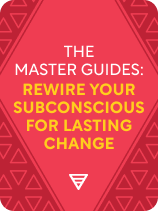

This article is an excerpt from the Shortform book guide to "The Master Guides: Rewire Your Subconscious for Lasting Change" by Shortform. Shortform has the world's best summaries and analyses of books you should be reading.
Like this article? Sign up for a free trial here.
Do you find it easy to start a new habit but nearly impossible to stick with it? What do you need to change about your approach to instill real change in your life?
It’s one thing to adopt a new habit. It’s another to make that habit stick and become part of your life. The key is to get your subconscious mind—not just your conscious mind—to want to adopt the new habit.
Keep reading to learn how to create habits that stick by aligning your subconscious with your new behaviors.
How to Create Habits That Stick
We’ve collected advice on how to create habits that stick from Napoleon Hill, Charles Duhigg, Tony Robbins, James Clear, and others. These authors contend that you can change your automatic routines by aligning your subconscious mind with your chosen habits. They emphasize that cultivating a positive attitude is key to achieving this alignment.
In The Law of Success, Napoleon Hill suggests that cultivating a positive attitude helps overwrite unwanted automatic routines with more productive ones. He explains that your attitude toward life determines the nature of your habitual thoughts—that is, whether they’re negative or positive—and the overall impression they make on your subconscious mind. This impression then influences your ability to act in alignment with your chosen habits.
Joseph Murphy (The Power of Your Subconscious Mind) adds that your subconscious mind operates according to your expectations: If you cultivate a positive attitude, you’ll naturally form positive expectations about adopting your chosen habit, and your subconscious mind will amend your automatic routines to reflect these expectations.
Let’s look at six methods that, when combined, will help you think more positively about your chosen habits—and make your subconscious mind want to adopt them.
Method #1: Repeat, Repeat, Repeat
According to Murphy, when you first try to change your habitual conscious thoughts, you’ll need to apply conscious effort to think positively. But, with repetition, your positive thoughts will eventually imprint upon your subconscious mind to form positive expectations and outweigh any negative expectations. As a result, your subconscious mind will influence you to think and behave in positive ways without conscious effort.
Method #2: Imagine the Benefits
Charles Duhigg (The Power of Habit) says that you’re more likely to think positively about your chosen habits—which will convince your subconscious mind to create supportive automatic routines—by reflecting on how rewarding they’ll feel or what specific benefits they’ll offer. He suggests you find ways to actively dwell on these benefits—by visualizing, anticipating, or imagining them.
Self-help guru Tony Robbins (Awaken the Giant Within) adds that, the more specific you are about your chosen habits, the easier it will be to imagine their benefits and develop positive expectations about adopting them. In addition, the more specific you are, the easier you’ll find it to plan and prepare for potential obstacles that might tempt you to revert to your unwanted habits.
Method #3: Redefine Your Beliefs
According to James Clear (Atomic Habits), as well as focusing on the benefits of your chosen habits, you also need to define the beliefs that will support your disassociation from your unwanted habits. This is because your habits are inextricably linked to what you believe about yourself. Your beliefs about yourself encourage your habits and your habits encourage what you believe about yourself: for example, “I smoke, therefore, I believe that I need cigarettes to be happy.”
He suggests that you replace your current beliefs with healthier ones that support the changes you seek to make: for example, “I am healthy and enjoy taking care of my body.”
Method #4: Use Affirmations and Visualizations
Louise Hay (You Can Heal Your Life) suggests that the most effective way to update your beliefs and convince your subconscious mind to create corresponding routines is to “affirm” what you want. For example, change your belief from “I don’t think I can be happy without cigarettes” to “I’m happy, healthy, and relaxed” and repeat this multiple times a day. Eventually, you’ll come to believe this affirmation, and your automatic patterns will align with your new beliefs.
However, Maxwell Maltz (Psycho-Cybernetics) argues that affirmations are not enough—your mind will automatically reject thoughts that don’t align with your established beliefs. He explains that the only way to change your beliefs is to regularly visualize and feel yourself behaving the way you want. This is because your subconscious mind operates according to how you feel, not how you think—this practice will train your mind to become more comfortable with the feeling of who you want to be, and it’s the only way to overcome old and unproductive beliefs.
Murphy also advocates visualizations, saying that they add weight to the impression your conscious thoughts form in your subconscious mind. Since your subconscious mind can’t tell the difference between imagination and reality, it will only know that you’re thinking about something often enough to create a detailed picture in your mind—and therefore, it must be true. The more you dwell on this image, the more likely your subconscious is to accept this image as an instruction about what routines it should create.
Method #5: Tune Into Your Subconscious Mind by Relaxing
When your mind is relaxed, it’s more receptive to affirmations and visualizations. According to Maltz, practicing physical relaxation will enable you to consciously control your imagination and, subsequently, your subconscious mind.
Murphy adds insight into Maltz’s idea: When you’re awake and alert, you can’t help but think about and judge everything around you—this is what your conscious mind is designed to do.
This creates problems when you’re trying to retrain your subconscious mind because you can’t change your habitual conscious thoughts and beliefs instantaneously; your mind needs time to get used to your new way of thinking. During this time, your conscious mind questions and contradicts the beliefs you want to change.
When you practice relaxation, Murphy suggests, you lull your conscious mind to sleep and have direct access to your subconscious mind without interference. Since your subconscious mind is more receptive to your thoughts when your conscious mind is relaxed, Murphy recommends that you regularly ponder how you want to think and behave before you go to sleep.
Method #6: Create New Feedback Loops With Behavioral Changes
Another essential part of retraining your subconscious mind is to behave in ways that reflect your chosen habits. Recall: Your subconscious mind creates routines based on what you habitually do as well as what you think and feel. Self-help speaker Joe Dispenza (Becoming Supernatural) puts it like this: Doing things the same way every day trains your subconscious mind to always expect the same things and to reinforce the status quo. This means nothing in your life can change unless you change your behaviors.
Maltz offers practical advice for changing your behaviors and, by extension, your habits: Begin with what you can realistically achieve. He explains that you’ll find it easier to complete small, achievable actions. And each time you do so, you’ll feel pride and boost your self-confidence. These positive feelings will train your subconscious mind to associate your new behaviors with pleasure. This in turn will create a positive feedback loop that will reinforce the new habits you want to adopt.
For example, you want to run 10 kilometers a day, but you don’t have an exercise routine nor do you believe that you’re healthy enough to adopt this habit. You begin by introducing a light exercise routine into your life so that you can start to view yourself as a healthy person. The more you view yourself as a healthy person, the more likely you are to continue exercising and feel the benefits. The more benefits you feel from exercising, the more likely you are to see yourself as a healthy person and adopt even more behaviors that support your chosen habit.

———End of Preview———
Like what you just read? Read the rest of the world's best book summary and analysis of Shortform's "The Master Guides: Rewire Your Subconscious for Lasting Change" at Shortform.
Here's what you'll find in our full The Master Guides: Rewire Your Subconscious for Lasting Change summary:
- Why the only way to change a bad habit is to rewire your subconscious
- Methods from experts such as Tony Robbins, Charles Duhigg, and Nicole LePera
- Why it's so important to take time for physical relaxation






